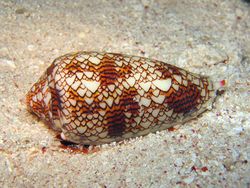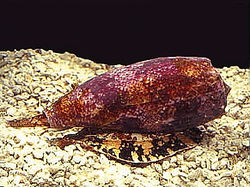Application of Ziconotide as a painkiller
Ziconotide can be extracted from the poison of cone snakes (Conus spp.), and belongs to the chemical family of the conopetides, a group which has received high attention for its potential use as painkillers. The Irish Elan cooperation brought a syntheticall version of the drug on the European markets in 2005 under the brand name Prialt® [1]. The drug is intended for use by patients suffering from intense and prolonged pain caused by e.g. cancer, aids or neuropathic pain [2], who get insufficient pain relief from classical painkillers.
Mode of Action
Ziconotide works by blocking ion channels in neurons, effectively stopping the transmission of pain signals. More specifically, ziconotide acts in a specific region of the spinal cords where nocireceptors connect to the neurons. Contrary to classical (strong) painkillers (such as e.g. morphine) this has the advantage of keeping the rest of the nervous system fully functional, preventing side effects such as general sedation and depressed respiration. Additionally, the ziconotide is reported to be a fifty to several thousand times more powerful painkiller then morphine [1]. However, for good results, ziconotide needs to be directly injected into the spinal cord, demanding the use of specialized systems and modes of administration. This reduces the use of ziconotide the most serious cases.
Origin & Development
Ziconotide is found in multiple species of the genus Conus. The substance was originally isolated from Conus magnus [3] and Conus geographus [4], but given its relatively small size, it can easily be synthetically replicated.


references
- ↑ 1.0 1.1 Kijjoa A and P Sawangwong. 2004. Drugs and cosmetics from the sea (review paper). Mar. Drugs 2004:73-82.
- ↑ http://www.iasp-pain.org/AM/Template.cfm?Section=Pain_Definitions
- ↑ http://www.marinespecies.org/aphia.php?p=taxdetails&id=215429 Conus magnus
- ↑ http://www.marinespecies.org/aphia.php?p=taxdetails&id=215499 Conus geographus
- ↑ http://bioweb.uwlax.edu/bio203/2011/haas_kayl/Dr%20Cm.htm
- ↑ http://www.nigms.nih.gov/news/findings/sept02/snails.html